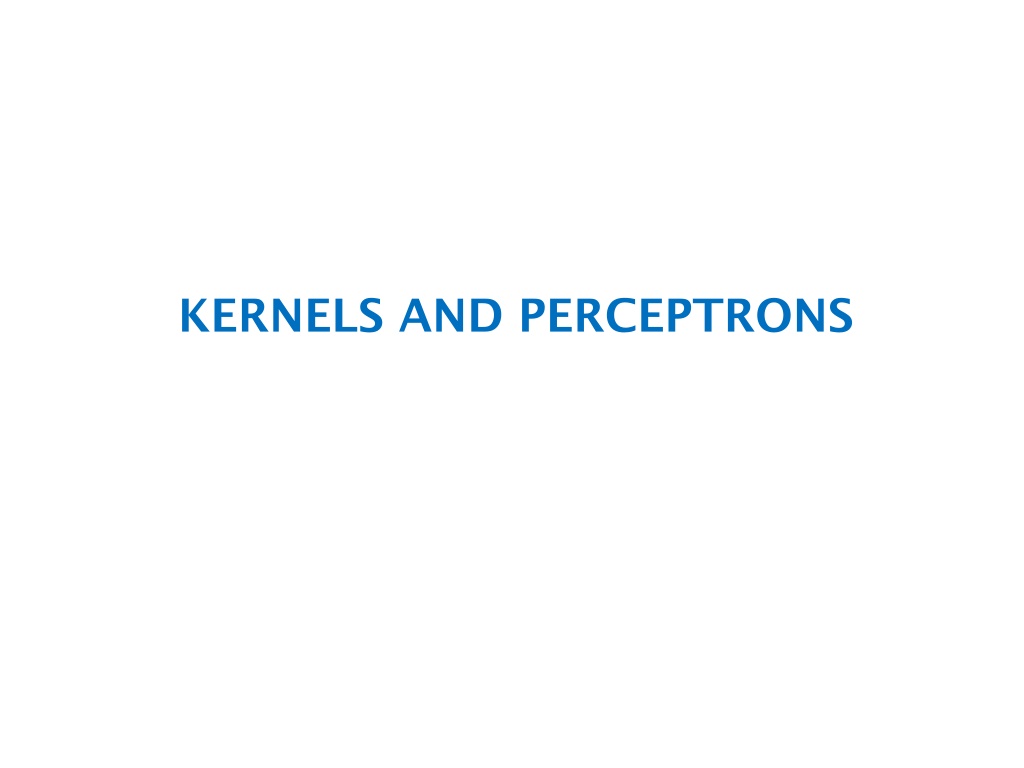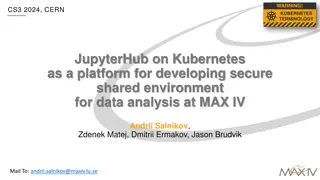Understanding Kernels and Perceptrons: A Comprehensive Overview
Kernels and Perceptrons are fundamental concepts in machine learning. This overview covers the Perceptron algorithm, Kernel Perceptron, and Common Kernels, along with Duality and Computational properties. It also explores mapping to Hilbert space and the computational approaches for achieving desired behavior.
Download Presentation

Please find below an Image/Link to download the presentation.
The content on the website is provided AS IS for your information and personal use only. It may not be sold, licensed, or shared on other websites without obtaining consent from the author. Download presentation by click this link. If you encounter any issues during the download, it is possible that the publisher has removed the file from their server.
E N D
Presentation Transcript
The perceptron x is a vector y is -1 or +1 ^ instancexi Compute: yi = sign(vk . xi) B A If mistake: vk+1 = vk + yixi ^ yi 2 yi R g mistake bound: k u Depends on how easy the learning problem is, not dimension of vectors x +x2 v2 > Fairly intuitive: Similarity of v to u looks like (v.u)/|v.v| (v.u) grows by >= after mistake (v.v) grows by <= R2 v1 -u 2 2
The kernel perceptron instancexi B A vk= xk+- .xk- ^ yi xk+ FN xk- FP yi ^ Compute: y=sign( .xk+- .xk-) xi xi Compute: yi = sign(vk . xi ) xk+ FN xk- FP x If false positive (too high) mistake add : to FP If mistake: vk+1 = vk + yixi i x If false positive (too low) mistake add : to FN i Mathematically the same as before but allows use of the kerneltrick 3
The kernel perceptron x x x x ( , ) K instancexi B k k A ^ y=sign( ,xk+)- K(xi K(xi ,xk-) yi xk+ FN xk- FP yi k k ^ = x x . x x . : Compute y Compute: yi = vk . xi + i i k k x x FN FP + x If false positive (too high) mistake add : to FP If mistake: vk+1 = vk + yixi i x If false positive (too low) mistake add : to FN i Mathematically the same as before but allows use of the kernel trick Other kernel methods (SVM, Gaussian processes) aren t constrained to limited set (+1/-1/0) of weights on the K(x,v) values. 4
Some common kernels x ) ' x x x ( , ' K Linear kernel: Polynomial kernel: ) 1 + d x ) ' x x x ( , ( ' K Gaussian kernel: 2 / e x x || '|| x ) ' x ( , K More later . 5
Kernels 101 Duality and computational properties Reproducing Kernel Hilbert Space (RKHS) Gram matrix Positive semi-definite Closure properties 6
Implicitly map from x to (x) by changing the kernel function K Explicitly map from x to (x) i.e. to the point corresponding to x in the Hilbert space Kernels 101 Duality: two ways to look at this k K k ( x y=x w + FN k = x x x x y ( , ) ( , ) K K + i i k k x x FN FP + k = + w x x x x x ( , ) ) ( ) k k x x FP k k = + k x ) w y ( k = + ) w x x ( ( ) k k x x FN FP Two different computational ways of getting the same behavior 7
Kernels 101 K(x,x ) = K(x ,x) Gram matrix is symmetric Duality Gram matrix: K: kij = K(xi,xj) 8
Kernels 101 Duality Gram matrix: K: kij = K(xi,xj) K(x,x ) = K(x ,x) Gram matrix is symmetric K is positive semi-definite zT Kz >= 0 for all z Fun fact: Gram matrixpositive semi-definite K(xi,xj)= (xi), (xj) for some Proof: (x) uses the eigenvectors of K to represent x 9
HASH KERNELS AND THE HASH TRICK 10
Question Most of the weights in a classifier are small and not important So we can use the hash trick 11
The hash trick as a kernel Usually we implicitly map from x to (x) All computations of learner are in terms of K(x,x ) = < (x), (x ) > Because (x) is large In this case we explicitly map from x to (x) (x) is small
Some details Slightly different hash to avoid systematic bias V[h]= j:hash( j)%R==h j xi { } j[h]= x(j)xi , where x(j) -1,+1 j j:hash(j)%m==h m is the number of buckets you hash into (R in my discussion) 14
Some details Slightly different hash to avoid systematic bias { } j[h]= x(j)xi , where x(j) -1,+1 j j:hash(j)%m==h m is the number of buckets you hash into (R in my discussion) 15
Some details I.e. a hashed vector is probably close to the original vector 16
Some details I.e. the inner products between x and x are probably not changed too much by the hash function: a classifier will probably still work17
Some details 18
The hash kernel: implementation One problem: debugging is harder Features are no longer meaningful There s a new way to ruin a classifier Change the hash function You can separately compute the set of all words that hash to hand guess what features mean Build an inverted index h w1,w2, , 19
Motivation What s the best learning rate? If a feature is rare, but relevant, it should be high, else learning will be slow Regularization makes this better/worse? But then you could overshoot the local minima when you train
Motivation What s the best learning rate? Depends on typical gradient for a feature Small fast rate Large slow rate Sadly we can t afford to ignore rare features We could have a lot of them
Motivation What s the best learning rate? Let s pretend our observed gradients are from a zero-mean Gaussian and find variances, then scale dimension j by sd(j)-1
Motivation What s the best learning rate? Let s pretend our observed gradients are from a zero-mean Gaussian and find variances, then scale dimension j by sd(j)-1 Ignore co-variances for efficiency
Motivation What s the best learning rate? Let s pretend our observed gradients are from a zero-mean Gaussian and find variances, then scale dimension j by sd(j)-1 Ignore co-variances for efficiency
Adagrad Gradient at time - covariances hgj t := wj- = 1 is usually ok 2 gt,j
Introduction Common pattern: do some learning in parallel aggregate local changes from each processor to shared parameters distribute the new shared parameters back to each processor MAP ALLREDUCE and repeat . AllReduce implemented in MPI, recently in VW code (John Langford) in a Hadoop/compatible scheme
Gory details of VW Hadoop- AllReduce Spanning-tree server: Separate process constructs a spanning tree of the computenodes in the cluster and then acts as a server Worker nodes ( fake mappers): Input for worker is locally cached Workers all connect to spanning-tree server Workers all execute the same code, which might contain AllReduce calls: Workers synchronize whenever they reach an all- reduce
Hadoop AllReduce don t wait for duplicate jobs
2 24 features ~=100 non- zeros/example 2.3B examples example is user/page/ad and conjunctions of these, positive if there was a click-thru on the ad
50M examples explicitly constructed kernel 11.7M features 3,300 nonzeros/example old method: SVM, 3 days: reporting time to get to fixed test error























